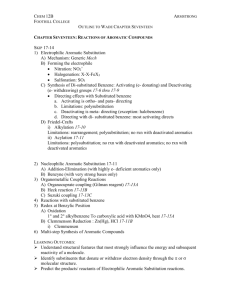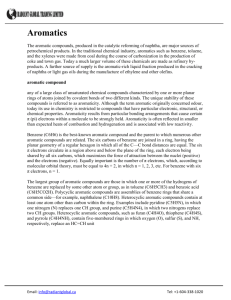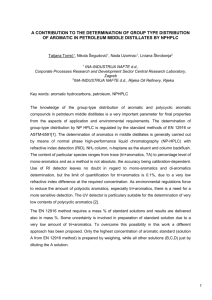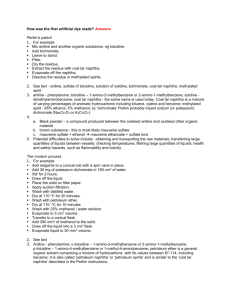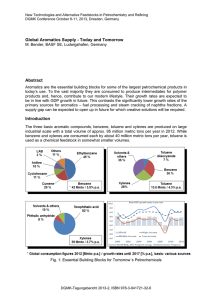الشريحة 1
advertisement
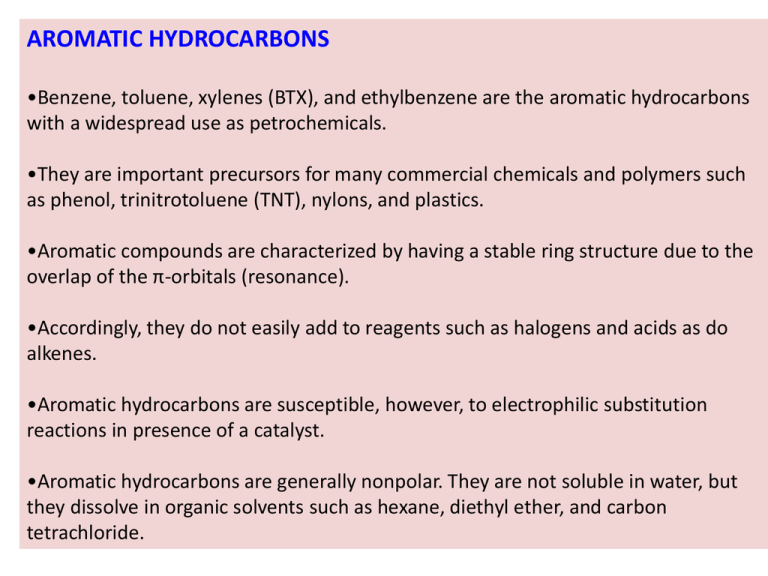
AROMATIC HYDROCARBONS •Benzene, toluene, xylenes (BTX), and ethylbenzene are the aromatic hydrocarbons with a widespread use as petrochemicals. •They are important precursors for many commercial chemicals and polymers such as phenol, trinitrotoluene (TNT), nylons, and plastics. •Aromatic compounds are characterized by having a stable ring structure due to the overlap of the π-orbitals (resonance). •Accordingly, they do not easily add to reagents such as halogens and acids as do alkenes. •Aromatic hydrocarbons are susceptible, however, to electrophilic substitution reactions in presence of a catalyst. •Aromatic hydrocarbons are generally nonpolar. They are not soluble in water, but they dissolve in organic solvents such as hexane, diethyl ether, and carbon tetrachloride. EXTRACTION OF AROMATICS • Benzene, toluene, xylenes (BTX), and ethylbenzene are obtained from the catalytic reforming of heavy naphtha. • The product is rich in C6, C7, and C8 aromatics, which is extracted by sulfolane or ethylene glycol. • These solvents are characterized by a high affinity for aromatics, good thermal stability, and rapid phase separation. The process is Tetra extraction process uses tetraethylene glycol as a solvent. • The feed (reformate), contains a mixture of aromatics, paraffins, and naphthenes heat exchange with hot raffinate, is countercurrentIy contacted with an aqueous tetraethylene glycol solution in the extraction column. • The hot, rich solvent containing BTX aromatics is cooled and introduced into the top of a stripper column. • The aromatics extract is then purified by extractive distillation and recovered from the solvent by steam stripping. The Union Carbide aromatics extraction process using tetraethylene glycol. EXTRACTION OF AROMATICS • The raffinate (constituted mainly of paraffins, isoparaffins and cycloparaffins) is washed with water to recover traces of solvent and then sent to storage. The solvent is recycled to the extraction tower. • The extract, which is composed of BTX and ethylbenzene, is then fractionated. Benzene and toluene are recovered separately, and ethylbenzene and xylenes are obtained as a mixture (C8 aromatics). • Due to the narrow range of the boiling points: C8 aromatics are separation by fractional distillation is difficult. A super-fractionation technique is used to segregate ethylbenzene from the xylene mixture. • p-xylene is recovered from the xylene mixture by fractional crystallization. • The overall yield of p-xylene is increased by incorporating an isomerization unit to isomerize o- and m-xylenes to p-xylene. • An overall yield of 90% p-xylene could be achieved. Flow diagram of the Mobil xylene isomerization process • In this process, partial conversion of ethylbenzene to benzene also occurs. The catalyst used is shape selective and contains ZSM-5 zeolite. Benzene • Benzene (C6H6) is mainly obtained from catalytic reforming. Other sources are pyrolysis gasolines and coal liquids. • Benzene is an important chemical intermediate and is the precursor for • many commercial chemicals and polymers such as phenol, styrene for poly-styrenics, and caprolactom for nylon 6. Ethylbenzene • Ethylbenzene (C6H5CH2CH3) is one of the C8 aromatic constituents in reformates and pyrolysis gasolines. It can be obtained by intensive fractionation of the aromatic extract. • ethylbenzene is obtained by the alkylation of benzene with ethylene. Methylbenzenes (Toluene and Xylenes) • Methylbenzenes occur in small quantities in naphtha and higher boiling fractions of petroleum. • The primary sources of toluene and xylenes are reformates from catalytic reforming units, gasoline from cat-cracking, and pyrolysis gasoline from steam reforming of naphtha and gas oils • Solvent extraction is used to separate these aromatics from the reformate mixture. • Toluene and xylenes have chemical characteristics similar to benzene, but these characteristics are modified by the presence of the methyl substituents. • Currently, the largest single use of toluene is to convert it to benzene. para-Xylene is mainly used to produce terephthalic acid for polyesters. • o-Xylene is mainly used to produce phthalic anhydride for plasticizers. LIQUID PETROLEUM FRACTIONS AND RESIDUES • Liquid Petroleum fractions are light naphtha, heavy naphtha, kerosine and gas oil. The bottom product from distillation units is the residue. • These mixtures are intermediates through which other reactive intermediates are obtained. • Heavy naphtha is a source of aromatics via catalytic reforming and of olefins from steam cracking units. • Gas oils and residues are sources of olefins through cracking and pyrolysis processes. Naphtha • Naphtha is the overhead liquid fraction obtained from atmospheric distillation units. • The light straight-run naphtha (LSR) boils at 35–90°C. • Heavy straight-run naphtha (HSR) boils at about 80–200°C . • Naphtha is also obtained from catalytic cracking, hydrocracking, and coking units. • The composition of naphtha, depends on production process. • Naphtha from atmospheric has no olefinic compounds. Its main constituents are straight and branched-chain paraffins, cycloparaffins (naphthenes), and aromatics, and the ratios of these components are mainly a function of the crude origin. • Naphthas obtained from cracking units contain variable amounts of olefins, higher ratios of aromatics, and branched paraffins. • Due to presence of unsaturated compounds, they are less stable than straight-run naphthas. • The absence of olefins increases the stability of naphthas produced by hydrocracking units. • In refining operations, however, it is customary to blend one type of naphtha with another to obtain a required product or feedstock. • The main use of naphtha in the petroleum industry is in gasoline production. • Light naphtha blended with reformed gasoline (from catalytic reforming units) to increase volatility and to reduce the aromatic content of the product gasoline. • Heavy naphtha from atmospheric distillation or hydrocracking units has a low octane rating. • Used as a feedstock to catalytic reforming units. • Catalytic reforming is a process of upgrading low-octane naphtha to a high-octane reformate by enriching it with aromatics and branched paraffins. • Reformates are the main source for extracting C6-C8 aromatics used for petrochemicals. Chapter 10 discusses aromatics-based chemicals. • Naphtha is also a major feedstock to steam cracking units for the production of olefins. • Naphtha could also serve as a feedstock for steam reforming units for production of synthesis gas. KEROSINE • Kerosine, a distillate fraction heavier than naphtha, is a product from distilling crude oils under atmospheric pressures. • Also be obtained as a product from thermal and catalytic cracking or hydrocracking units. • Cracking Kerosines are less stable than those produced from atmospheric distillation and hydrocracking due to presence of variable amounts of olefinic constituents. • Kerosine is usually a clear colorless liquid which does not stop flowing • except at very low temperature (normally below –30°C). • Kerosine containing high olefin and nitrogen contents, develops some • color (pale yellow) after being produced. • The main constituents of kerosines obtained from atmospheric and hydrocracking units are paraffins, cycloparaffins, and aromatics. • Kerosines with a high normal-paraffin content are feed-stocks for extracting C12-C14 n-paraffins, which are used for producing biodegradable detergents. • Currently, kerosine is used to produce jet fuels, after some treatment to adjust freezing point. • Before the widespread use of electricity, kerosine was extensively used to fuel lamps and domestic heating conditions. Gas Oil • Gas oil is a heavier petroleum fraction than kerosine. • Obtained from the atmospheric distillation of crude oils (atmospheric gas oil, AGO), from vacuum distillation of topped crudes (vacuum gas oil, VGO), or from cracking and hydrocracking units. • AGO is relatively low in density and sulfur content than VGO. • The aromatic content depends on the origin. • A major use of gas oil is as a fuel for diesel engines and as a feedstock to cracking and hydrocracking units. • Gases produced from these units are suitable sources for light olefins and LPG. • LPG may be used as a fuel, as a feedstock to steam cracking units for olefin production, or as a feedstock for a Cyclar unit for the production of aromatics. Residual Fuel Oil • Known as the bottom product. Unstable. When used as fuels, they produce smoke and deposits that may block the burner orifices. • Complex than gas oils. Contains polynuclear aromatic compounds, asphaltenes, and heavy metals found in crude oils is concentrated in the residue. • Fuel for power generation. Process fuel in many petroleum and chemical companies. low market value , it is used as a feedstock to catalytic and thermal cracking units. • Residues containing high levels of heavy metals are not suitable for catalytic cracking units. • Subjected to a demetallization process to reduce their metal contents. By selective solvent extraction. • Low-metal fuel oils are suitable feedstocks to catalytic cracking units. Product gases from • cracking units may be used as a source for light olefins and LPG for petrochemical production. Residual fuel oils are also feedstocks for steam cracking units for the production of olefins.
